The University of Texas at Austin's Department of Electrical and Computer Engineering in the Cockrell School of Engineering (Texas ECE) announced the winners of the Spring 2015 Senior Design program while celebrating graduates at the 2015 Graduate Reception on Monday, May 11, 2015 in the Texas Union Ballroom.
Industry Collaborators
UT ECE is deeply appreciative of our industrial collaborators, whose expertise and support makes these projects successful and meaningful. Industry project sponsors for the Spring 2015 projects include AT&T, Alderman Family, Baker Hughes, Cameron, Dun & Bradstreet, National Instruments, Plantronics, Qualcomm, Texas Instruments, and Xilinx.
First, second and third place winners were selected in both the Honors and Non-Honors categories. Winning team members each received prizes generously provided by Apple which included iPad minis, Beats headphones, and Apple TVs for first, second and third places, respectively. Winners were announced by Prof. Gary Hallock, who taught the course, and Prof. Mark McDermott.
View videos of Senior Design projects | See Photos from the Senior Design Open House | See Photos from the Graduation and Awards Reception
Honors Category
First Place
WISE – Wind Integration and Stabilization Environment
Team: Scott Barron, David Leppo, Uchenna Ndusorouwa, Matthew Sereda, Michael Stephens, Matthew Young
Faculty Mentor: Surya Santoso
Project WISE is a power system test-bed that allows the simulation of power quality phenomena caused by the variability of wind power generation. It has three subsystems, consisting of a model power grid, wind turbine, and a monitoring and control system. The power grid is a scaled-down representation using three phase 208 V circuits to model a 100 mile 345 kV system. It contains power transformers, inductors, capacitors, circuit breakers, contactors, and resistive load banks. The wind turbine simulates the power output of a Type-1 wind turbine, and consists of a DC motor, induction generator, control system, and reactive power support. The monitoring and control system captures three phase instantaneous voltage and current at nine different locations along the transmission and distribution lines, processes the data, and enables display and remote control of contactors through a touch screen user interface.
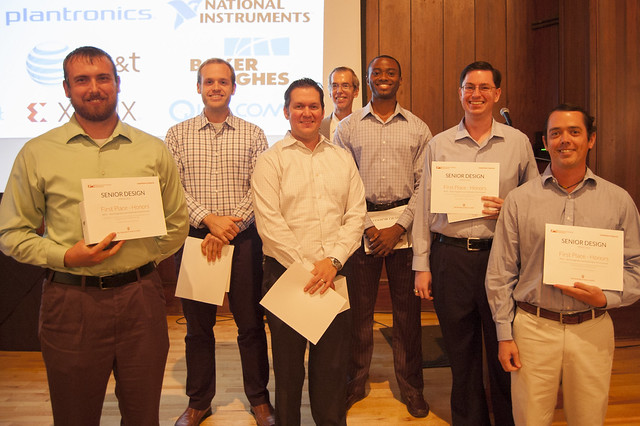
Second Place
ChemSense – Lab on Chip Chemical Sensing
Team: Travis Brannen, John Elson, Steven Prickett, Kaarthik Rajendran, Aaron Treptow, Parker Wray
Faculty Mentor: Ray Chen
ChemSense is a portable system for detecting hazardous airborne chemicals. The project integrates a tunable, mid-infrared laser spectrometer in a portable low power package. Their device replaces hundreds of pounds of laboratory equipment normally used in absorption spectroscopy with a single, hand-held unit. The team designed and integrated the laser driver and photodetector post amplifier circuits on a printed circuit board, to enable miniaturization of the system. For increased flexibility the device incorporates Bluetooth low energy connectivity and a dedicated Android application. This allows data analysis and display of gas concentrations on both the handheld unit and a remote smartphone.
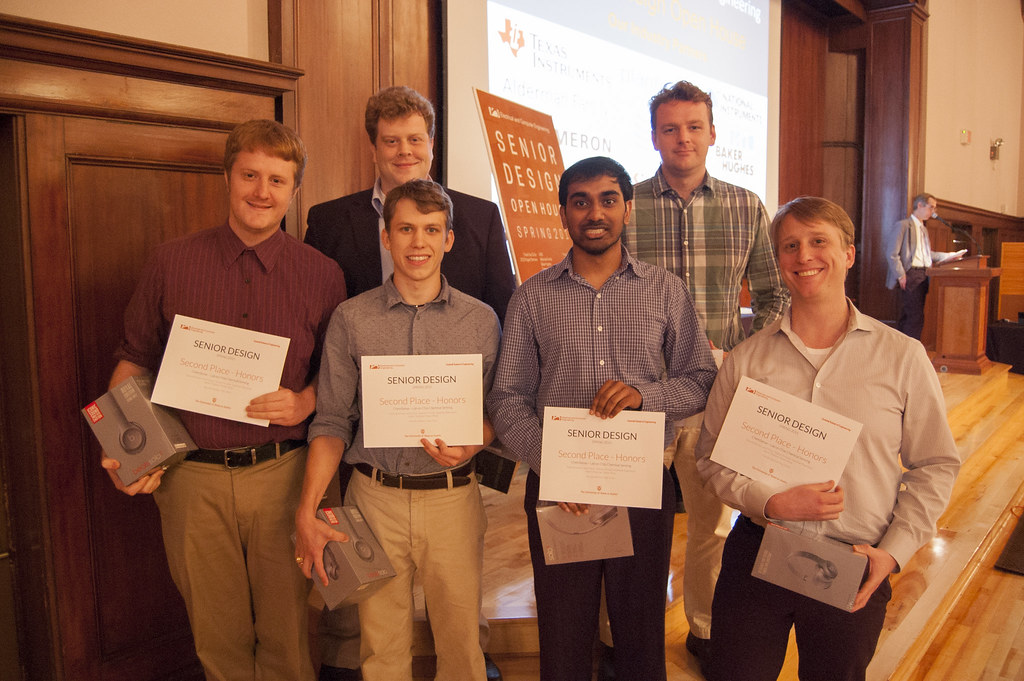
Third Place
ADX – An ARMv4 Architecture with Datapath Extensions
Team: Nikhil Dixit, Jia-Ching Hsu, Minesh Patel, Chirag Sakhuja
Faculty Mentor: Yale Patt
Project ADX extended the ARM instruction set architecture, or ISA, with the goal of improving the processor’s speed. First the team designed and implemented their entire processor in a hardware modeling language called SystemC. Then they implemented their extensions. They also created an ARMv4 compatible C library to run arbitrary C programs on their processor. They created complex tools to evaluate their design, and measured the performance of their extensions. Increased speed was obtained in almost every program they ran. This project is similar in scope to projects taken on by advanced graduate students.
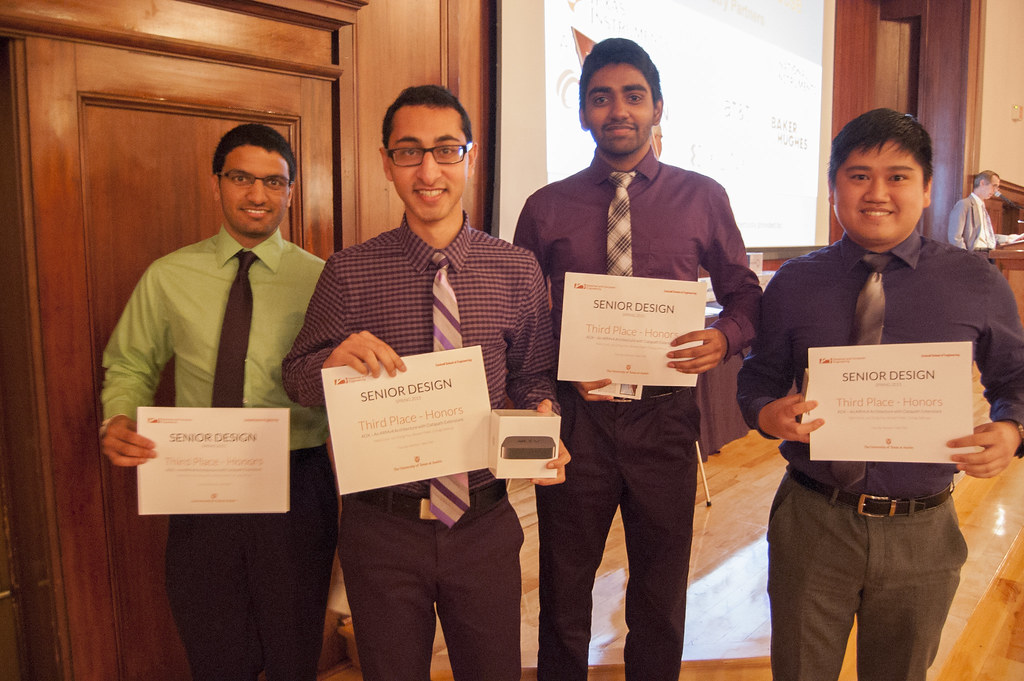
Non-Honors Category
First Place
BIAS – Brake Pad Indication and Abrasion Sensor
Team: Trey Franklin, Heejun Kim, Erik Lopez, Benjamin Lytle, Carter McBride, Zachary Parrish
Project Partner: Texas Instruments
Faculty Mentor: Gary Hallock
This team developed a brake pad indication and abrasion sensor, a device that mounts to an existing braking system and provides the user with real-time brake pad wear information via an Android application. The sensor uses an inductive coil to measure the distance of the brake pad from the rotor, providing accurate measurements over the entire lifespan of the brake pad. Using the measurements, an algorithm provides the user with future wear prediction, and an estimate on when the brake pad should be replaced. BIAS connects to an Android phone via a Bluetooth connection, and can be accessed anytime the user is near his or her vehicle.
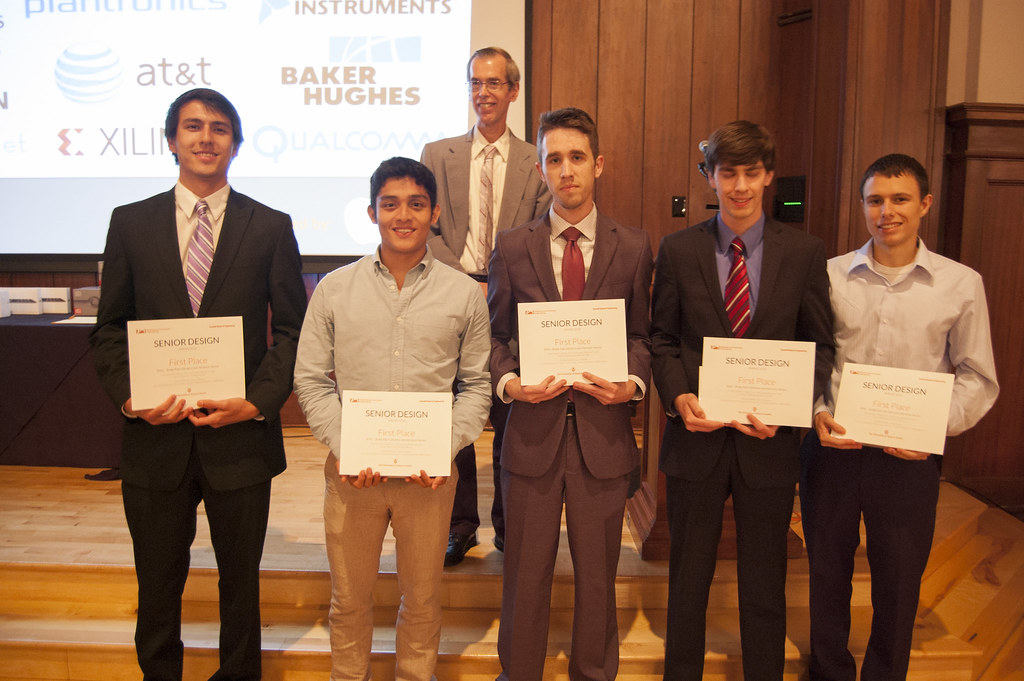
Second Place
GroBot – Power Controller for Hydroponic Systems
Team: Jacob Boydston, Felix Cruz, Conan Gammel, Ryan Garcia, James Schulman, Matthew Waits
Project Partner: Texas Instruments
Faculty Mentor: Deji Akinwande
This team created a low cost, unified power distribution system to power lights and a water pump for an indoor home hydroponics setup. Their device has internet connectivity, and can be programmed on a user defined schedule via a webpage. Lighting optimization is provided to fit varying growing cycles. The system is highly modular to easily allow changes or additional devices. This project could open up home hydroponic growing to new amateur and economical markets.
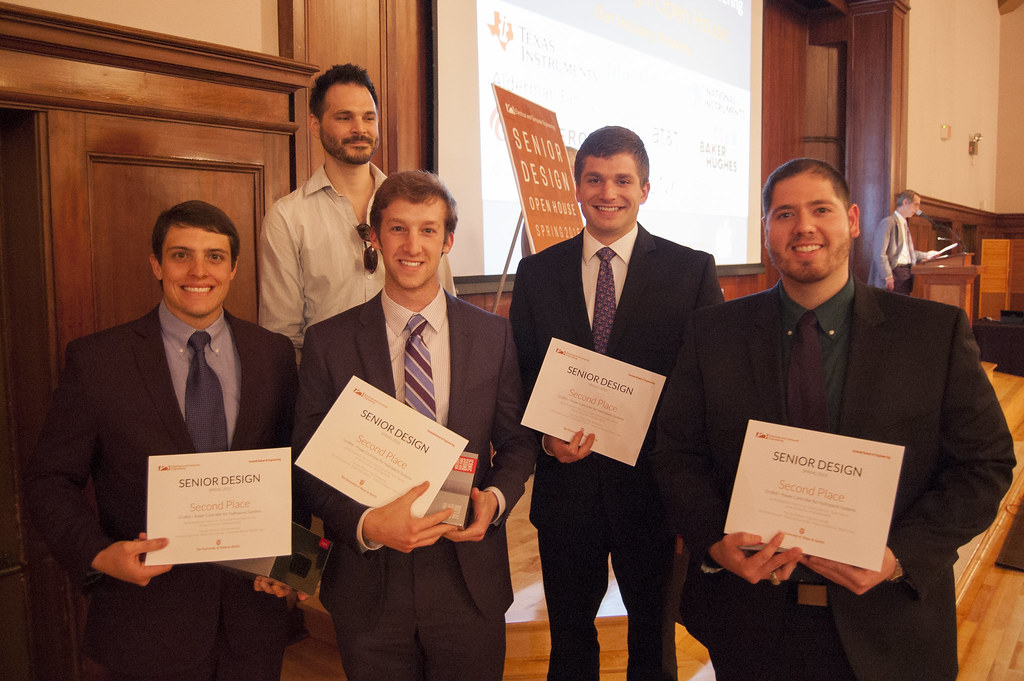
Third Place
TempSense -- Wireless Temperature Sensor
Team: Asif Amin, Jason-Quoc Nguyen, Ulises Osorio, Juan Salas, Lauro Salinas, Max Sigrist
Project Partner: Texas Instruments
Faculty Mentor: Ranjit Gharpurey
TempSense is a wireless temperature and humidity monitoring system for industrial settings. The team implemented sensor nodes which collect the data remotely and communicate it over WiFi. Their design is very practical and useful, and can be deployed in homes and commercial environments such as large grocery stores where humidity and temperature need to be precisely controlled. It leverages existing networks for data communication, and potentially for locating the sensor units. Finally, their device uses solar charging to harvest available light and extend the battery life.

Upper division undergraduate students in UT ECE complete a required capstone design course sequence. In the courses, students solve open-ended problems submitted by industrial collaborators. Students work in small groups over two semesters to identify an opportunity, define the problem, analyze competing needs and requirements, perform prior art and patent searches, develop alternative designs, carry out cost analyses, and select and implement a design solution.
Companies partner with faculty and student teams, providing funding, equipment, industry expertise, and mentoring as the team works toward a successful outcome to their design problem.
Industry Collaborators
UT ECE is deeply appreciative of our industrial collaborators, whose expertise and support makes these projects successful and meaningful. Industry project sponsors for the Spring 2015 projects include AT&T, Alderman Family, Baker Hughes, Cameron, Dun & Bradstreet, National Instruments, Plantronics, Qualcomm, Texas Instruments, and Xilinx.
